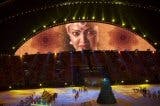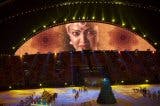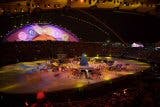The curved screen is in keeping with the circular structure of the stadium. The entire 77-mm pitch LED screen is 165 meters wide along the curve, reaching 39 meters at its highest point. The screen is comprised of 20,000 individual Versa RAY fixtures, containing a total of 762,000 individual LEDs. The linear fixtures have RGB LEDs positioned every 77 mm, and if laid end to end would span 58 km (over 36 miles).
The massive size of the display – covering over 4,500 square meters, or 45,000 square feet – allowed it to be used in ways previously unachievable. It was both an integral element of the show on the field as well as an informative display during the Parade of Athletes. Hours of rich, beautiful content were created specifically for the Ceremonies to dazzle the audience and make the event unlike anything seen before.
The Versa RAYs themselves were mounted onto large trusses with integral catwalks called “spines”. These spines are approximately 11 meters long and hold 148 Versa RAYs in varying lengths, from 750 millimeters to 3 meters. “It’s a pretty massive piece of kit when it’s all put together,” Varrin said. “The spines were assembled and tested in the stadium’s parking lot over a period of a couple of months.” Once completed, the spines were hoisted into place on the enormous steel support structure via crane, and assembled into the final screen.
Element Labs built redundancy into every aspect of the screen, including redundant video feeds, processing, data distribution and power supplies. “Redundancy is crucial. This is a live show, with no second chances, and with the ceremonies being an important part of the event, there is no room for error,” Varrin says. “We employed an interlaced configuration with the Versa RAYs to give an additional layer of redundancy beyond what’s normally done.”
Sharif Hashisho, Director of Ceremonies & Cultural Events at DAGOC said, "At every Olympic standard ceremony there are a number of new technologies that need to be introduced and revealed within the ceremony. In our ceremony the LED screen was one of these technological elements that led to the great achievement of making the Doha 2006 ceremonies the best ever in the history of all previous games. We have raised the bar so high and made both the Beijing and London Olympics organizing committees worried about what they can do next."
Presided over by His Highness Sheikh Hamad Bin Khalifa Al-Thani, the Emir of the State of Qatar, the Opening Ceremony featured 7,000 dancers, singers, acrobats and aerialists along with 10,000 plus athletes and officials. The 50,000 strong, sold-out crowd saw representatives from 45 countries and regions.







